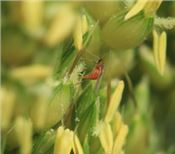|
Sorghum Midge Uptick Prompts Scouting Courses

This year, producers planted about 90,000 acres of grain sorghum throughout the state. Early plantings have been affected more than usual by the sorghum midge, an insect that feeds on plants while they are in bloom.
STARKVILLE, MISS.
Sorghum midges have been an issue for Mississippi grain sorghum producers for as long as they have been growing the crop, but early plantings across the state have been affected more than usual this year.
Jeff Gore, an entomologist with the Mississippi State University Extension Service and Mississippi Agricultural and Forestry Experiment Station, said he has fielded calls from farmers who report increasing problems with the crop-compromising insect across the state – an indication that the issue is not isolated to a specific area.
“I wouldn’t say it has become a major problem yet, but I’ve been getting several calls about scouting for midge in grain sorghum,” Gore said. “It’s been going on since late June, and we’re getting a lot of calls relative to the amount of grain sorghum we’re growing.”
Early grain sorghum plantings do not usually experience large populations of midges, which only feed on the crop during each planting’s four- to five-day blooming window. The risk of infestation is higher with later plantings of the crop.
This year, producers planted about 90,000 acres of grain sorghum throughout the state. Extension row-crops entomologist Angus Catchot said 30 to 40 percent of early plantings have had thresholds of the insect. Catchot said he anticipates that later plantings will see significantly higher percentages of affected acres.
“Midge is present and well above thresholds in some fields, which is one midge per head,” Catchot said. “One thing that complicates midge at this time is the sugarcane aphid factor. The pyrethroid insecticides producers use to eliminate aphids will also kill beneficial insects, such as lady beetles and syrphid flies, which feed on aphids. When you take those out, aphids don’t have anything to keep them in check.
“Even though we have the potential to flare sugarcane aphids with a midge spray, it is very important that we take care of midge if they are above threshold,” Catchot added.
MSU entomologists recommend growers wait until the midges are present before spraying for midges when numbers reach the threshold.
“The way most people used to treat midge was to make automatic pyrethroid applications when sorghum was at 30 percent bloom,” Gore said. “Now, people are paying attention because they don’t want to open the door for more aphids. They’re trying to scout the right way.”
Because midges are tiny insects, they are tough to see.
“If the growers don’t find midge, they start worrying that they’re not finding them because they don’t have confidence in their own scouting ability,” Gore said. “The reason people are nervous about their scouting ability is because even though the midge is a tiny insect that you wouldn’t think could be problem, it could be devastating in terms of yield losses.
“The thought is spraying for midge even if they don’t have them is not going to cost them as much as if they don’t spray and do have an infestation,” he said.
Automatic sprays for midges were common before sugarcane aphids started becoming an issue themselves.
“Now, through hands-on training, we have been able to give scouts the confidence in finding and scouting for sorghum midge and avoiding automatic applications,” Catchot said.
In response to the calls they have gotten from producers, Gore and Catchot held a sorghum midge scouting field day July 13 at the MSU Delta Research and Extension Center in Stoneville. They are scheduling more workshops across the state.
“It’s very important that consultants, retailers and growers know how to look for midge,” Catchot said. “We plan to use a couple of the MSU experiment stations and the Starkville campus, where we have midge present on research plots, as an opportunity to bring small groups in and train them so they’ll have confidence that they know how to scout them going forward.”
For updates on future midge scouting workshops, visit the MSU Extension Mississippi Crop Situation blog at http://www.mississippi-crops.com. ∆
|
|